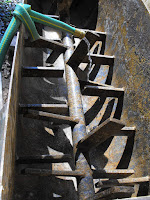
I've been playing with the "Big One" the last couple of days. It's a circa mid 1960's Paoli clay mixer. I'm still trying to figure out how it's best use is.
I started by scrubbing the interior and rinsing. There was a fair amount of rusty bits in there. Then I dumped the red dirt of varying wetness/dryness.
On top of the dirt I put in the rest of the dry materials.

The mixer goes "forward" and "backward" and I used this feature to keep the mix in the main mixing section. Yesterday I mixed a small batch of red dirt clay and today mixed up a big batch of the sandy version.
 the sand station in the distance.
the sand station in the distance.
the sun and wind helped dry out
the sand which helped in sieving it.
We have a huge pile of sand left over from Stacey's paving project and it adds a bit more texture to the clay. I tested it out last firing as well as doing a calcium test with some muriatic acid. However, it contains some material that is too large. To get the little stones out I dried the sand and shook it through my sieve. I know, it does seem like a lot of trouble...but nothing but the best! (keepin' it local)
;-)
Here's the recipe. If you have a local red clay, fire in a wood kiln to about cone 9 1/2 and use salt, then you may get close.
On top of the dirt I put in the rest of the dry materials.

The mixer goes "forward" and "backward" and I used this feature to keep the mix in the main mixing section. Yesterday I mixed a small batch of red dirt clay and today mixed up a big batch of the sandy version.
 the sand station in the distance.
the sand station in the distance.the sun and wind helped dry out
the sand which helped in sieving it.
;-)
Here's the recipe. If you have a local red clay, fire in a wood kiln to about cone 9 1/2 and use salt, then you may get close.




